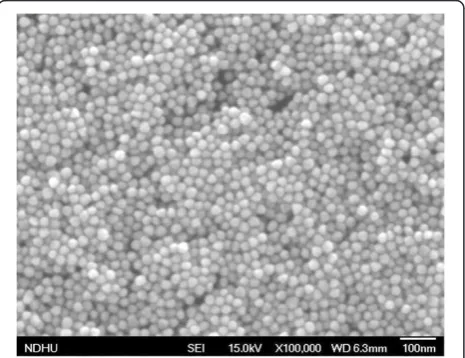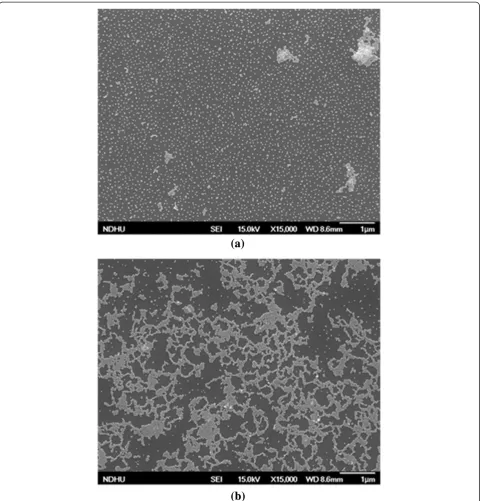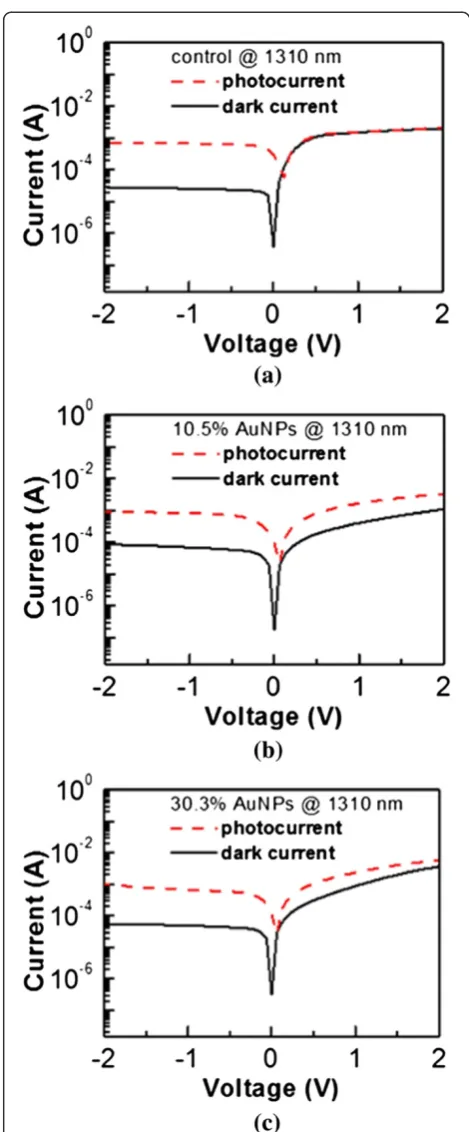N A N O E X P R E S S
Open Access
The n-type Ge photodetectors with gold
nanoparticles deposited to enhance the
responsivity
Hao-Tse Hsiao
1, I-Chih Ni
2, Shien-Der Tzeng
2, Wei-Fan Lin
1and Chu-Hsuan Lin
1*Abstract
Gold nanoparticles (AuNPs) have been deposited on n-type Ge photodetectors to improve the responsivity. Two different coverage ratios, including 10.5 and 30.3% of AuNPs have been prepared, and the fabricated photodetectors are compared with the control sample. The 1,310-nm responsivities at−2 V of the control, 10.5% AuNPs, and 30.3% AuNPs samples are 465, 556, and 623 mA/W, respectively. The AuNPs could increase the responsivities due to the plasmon resonance. The reflectance spectra of these samples have been measured to verify that plasmon resonance contributes to the forward scattering of incident light. The reflectance decreases with AuNP deposition, and a denser coverage results in a smaller reflectance. The smaller reflectance indicates more light could penetrate into the Ge active layer, and it results in a larger responsivity.
Keywords:AuNP; Ge photodetector; Responsivity
Background
Photodetectors are widely used in various fields in our daily life [1,2]. The detection wavelength of a photo-detector depends on the choice of the active semicon-ductor material. Si is a common semiconsemicon-ductor material for use in photodetectors due to its abundant existence on Earth. The bandgap of Si is 1.12 eV, which corresponds to a cutoff photodetection wavelength of 1,100 nm. Visible light and one of the common bands of near infrared, 850 nm, can be detected well by Si. However, other important near-infrared bands, including 1,310 and 1,550 nm, cannot be absorbed by Si [3]. The low-loss and low-dispersion characteristics of infrared light in fiber at these wavelengths make these wavelengths necessary in optical communication [4,5]. Ge, an element in the same group IV as Si, has a smaller bandgap of 0.66 eV, and it can be used for light detection at these wavelengths [6,7]. Various approaches have been tried to boost the pho-toresponses (responsivities) of Si photodetectors [8-11]. Among them, the investigation of the use of metallic nanoparticles has grown rapidly in the last decade [11-14].
However, few studies have touched on the topic of photoresponse enhancement of Ge based on metallic-nanoparticle incorporation [15]. Metallic metallic-nanoparticles on a semiconductor could contribute to the plasmonic interaction, which could result in forward scattering of incident light into the semiconductor to enhance the photoresponse [15,16]. Such plasmon resonance can be used in solar cells, although it may upgrade the (quantum) efficiency at certain wavelengths while degrading at other wavelengths [17]. As compared to applications on solar cells, where broadband utilization is needed, photodetec-tors could benefit more from plasmonic interaction, since only improvement of a certain wavelength is needed. In this manuscript, gold nanoparticles (AuNPs) have been deposited on the Ge photodetector. The reflectance and responsivities of n-type Ge photodetectors with and with-out AuNPs covering will be compared to show the enhancement contributed by AuNPs.
Methods
Experimental details AuNPs preparation
First of all, AuNPs should be prepared in order to de-posit them on Ge substrates. The solution of AuNPs was
* Correspondence:chlin0109@mail.ndhu.edu.tw
1
Department of Opto-electronic Engineering, National Dong Hwa University, Shoufeng, Hualien 974, Taiwan
Full list of author information is available at the end of the article
obtained by the method of gold salt reduction [18,19]. Trisodium citrate (TSC) and tannic acid (TA) were used
to deoxygenate HAuCl4 into AuNPs. With 0.5 mL TA
(1%) added to 1-L solution, the 12-nm AuNPs were first
formed. If HAuCl4 and TSC could be continuously
added, the particle size could be enlarged. In this manu-script, the AuNPs with a size of ~30 nm were used. In order to obtain more precise estimation of the sizes and shapes of AuNPs, dense AuNPs were photographed by field-emission scanning electron microscope (FESEM) as shown in Figure 1. The size of AuNPs was 30 ± 3 nm, and the shape was close to spherical. The AuNPs should be modified by 8-mercaptooctanoic acid (MOA) to cause the nanoparticles to become negatively charged in order to avoid agglomeration in the solution. These modification molecules had two terminals. One terminal was the sulfur atom, which could be easily bonded with the AuNP. The other terminal was the functional group of -COOH. NaOH was added to increase the pH value, and the functional groups of -COOH were transformed into -COO−. AuNPs
attached by negatively-charged -COO− groups were
repulsive, and hence, agglomeration could be avoided. The pH value would be a critical parameter influencing the distribution and density of deposited AuNPs on sub-strates since the amount of negative charge would affect agglomeration and precipitation in the following steps.
AuNPs could be coated on n-Ge by the method of centrifugation. Before centrifugation, a specific centrifuge tube was prepared. The polydimethylsiloxane (PDMS) was put and tilted at a certain angle in the bottom of the tube in order to provide a vertical surface in the procedure of centrifugation [18]. Subsequently, the Ge substrate was put on the top of PDMS, and the solution of AuNPs was
added into the tube. During centrifugation, the AuNPs in solution were forced to bond onto the Ge substrate due to the centrifugal force. With the Ge substrate placed perpendicularly to the centrifugal force, a uniform film of AuNPs could be deposited. The deposited AuNPs film might be more than one layer, and the substrate could be immersed in water to remove the upper layers. A single layer of AuNP could then be obtained. FESEM photo-graphs of AuNPs on Ge obtained by solutions with two different pH values are shown in Figure 2a, b. To estimate the coverage, the color scales of the FESEM pictures were first transformed to gray levels using the commercial graphics tool, Photoshop. Then, we adjusted the contrast of the photograph to get only two values, black and white, where the parts covered by AuNPs was represented by the color white. Afterward, we used Matlab to transform the photograph into a binary bitmap. The black blocks were represented by the digit zero while white ones were repre-sented by the digit one in the binary bitmap. Finally, the respective numbers of ones and zeros were counted and calculated to obtain the ratio of the number of ones to the total amount, which corresponded to the coverage ratio. Figure 2a shows the sample of ‘10.5% AuNPs,’which was prepared by the AuNP solution with a pH value of 4, and the coverage ratio of AuNPs was estimated to be ~10. 5% on Ge. If the pH value was only slightly decreased, the dis-tribution of AuNPs on Ge became much denser, as shown in Figure 2b, with the‘30.3% AuNPs’sample possessing an AuNP coverage ratio of 30.3%. The pH value of the 30.3% case was very close to 4, but it should be slightly smaller than 4, if it is to result in a larger coverage density. Any small variation or error would result in a large variation in coverage. Hence, FESEM imaging is a significant tool for determining the final coverage ratio after AuNP depos-ition. The AuNPs on 10.5% AuNPs is highly dispersive, and AuNPs start to aggregate on 30.3% AuNPs.
Photodetector fabrication
Circular Al gates with areas of 5 × 10−4cm2 were then deposited on top of Ge substrates to form the photode-tectors. Large-area C-shaped Al was also deposited to act as surrounding ohmic contacts at the same time. In order to identify the effect contributed by the AuNPs, the control sample (control) without AuNPs was also prepared, for comparison.
Photoresponse measurement
[image:2.595.58.291.516.695.2]The schematic structure of an n-type Ge photodetector with AuNPs and the setup used to measure the photo-response are shown in Figure 3. The laser diode with an emission wavelength at 1,310 nm and an optical power of 1.5 mW was irradiated at the edge of the circular Al gate to measure the photoresponse. The core size of the fiber output of the laser diode is 9 μm, which is much
larger than each nanoparticle (~30 nm), and hence, the measured optical characteristics would be contributed by the abundant AuNPs.
Results and discussion
To find the maximum response, we continuously moved the tip of the fiber output inward into the Al gate and
[image:3.595.58.542.88.590.2]measured the respective photocurrents. The alternate photocurrents and dark currents were measured until the representative current levels were obtained. It was found that the photocurrents gradually increased to the saturated maximum as the tip of the fiber output was moved inward into the gate and then decreased due to the blockage of light by the electrode. Hereafter, we only
show the representative maximum photocurrent and the representative dark current.
The current–voltage (I-V) curves of the control, 10.5% AuNPs, and 30.3% AuNPs samples are shown in Figure 4a, b, c, respectively. For photodetectors with rectifying-diode behaviors, photodetectors are always operated at the re-verse bias with a lower dark current. Since the semicon-ductor, Ge in our study, is n-type, a negative bias applied to the gate is corresponding to a reverse bias. The photo-current and dark photo-current of the control are 7.25 × 10−4 and 2.82 × 10−5 A at −2 V, respectively (Figure 4a). The responsivity of the control is therefore 465 mA/W since the output optical power of the laser diode is 1.5 mW. When n-Ge is covered by 10.5% AuNPs, the photocurrent and dark current become 9.2 × 10−4 and 8.64 × 10−5 A at−2 V, respectively (Figure 4b), and the responsivity can achieve 556 mA/W. As compared to the responsivity of 465 mA/W of the control sample, the responsivity of
556 mA/W of 10.5% AuNPs increases 20% (i.e., (556–
[image:4.595.303.538.84.651.2]465)/465 = 20%). When the AuNP coverage ratio increases to 30.3%, the photocurrent is further increased to 9.9 × 10−4 A, while the dark current is 5.5 × 10−5A at−2 V (Figure 4c). Therefore, the 30.3% AuNPs sample has a responsivity of 623 mA/W. AuNPs can increase the responsivity of photo-detectors, and a denser coverage ratio results in a larger responsivity. As mentioned, the enhancement of respon-sivities may be contributed by the forward scattering of plasmon resonant nanoparticles. In order to confirm that the forward scattering indeed occurs, the reflectance spec-tra of the control, 10.5% AuNPs, and 30.3% AuNPs sam-ples are compared and shown in Figure 5. The reflectance spectrum is measured by reflective Fourier transform in-frared (FTIR) spectroscopy with an incident angle of 15° relative to normal incidence. The reflectance at 1,310 nm of the control, 10.5% AuNPs, and 30.3% AuNPs samples are 0.68, 0.65, and 0.61, respectively. The deposition of AuNPs can indeed decrease the reflection of incident light, and a larger coverage ratio results in a smaller ref-lection. More light can be absorbed by the sample with
Figure 3The structure of the n-type Ge photodetector with AuNPs covering it and the setup used to measure the photoresponse.The tip of the fiber was tilted at 45 degrees and pointed toward the edge of the circular Al gate with an optical power of 1.5 mW.
[image:4.595.57.293.89.188.2]denser AuNPs, which contributes to the enhancement of responsivities.
Reflectance or photocurrent spectra in ref. [16,17] were measured to show the effects of plasmon resonance. We have measured the reflectance spectra as shown in Figure 5. Regarding the photocurrent spectra, we have also mea-sured the photocurrent at the wavelength of 650 nm and combined with the 1,310-nm results to sketch the approxi-mate responsivity (directly related to the photocurrent) spectra (Figure 6). With denser AuNPs covering, the re-flectance can decrease and the responsivity can increase for a wide range of wavelengths. Such experiment re-sults support the photocurrent contribution of AuNPs on Ge.
Conclusions
The n-Ge photodetectors with and without AuNPs co-vering them are compared. The deposition of AuNPs can decrease the reflectance of near-infrared via the plasmon resonant nanoparticles. With a coating ratio of 10.5% AuNPs, the reflectance can decrease 4.4%, and the respon-sivity increases 20% as compared to the control sample. If the coverage ratio of AuNPs increases to 30.3%, the reflectance can decrease 10%, while the responsivity increases 34%. AuNPs is obviously beneficial for Ge near-infrared photodetection.
Competing interests
The authors declare that they have no competing interests.
Authors’contributions
HTH and WFL performed the detector fabrication and the measurement. ICN and SDT assisted with the deposition of AuNPs and provided the discussion of the properties of AuNPs. CHL conceived the experimental plan, modified the process flow, and prepared the manuscript. All authors read and approved the final manuscript.
Acknowledgements
The authors are grateful to the National Nano Device Laboratories of the R.O. C. for the facility access. This work is supported by National Science Council of R.O.C. under contract no. NSC 101-2221-E-259 -023 -MY3.
Author details 1
Department of Opto-electronic Engineering, National Dong Hwa University, Shoufeng, Hualien 974, Taiwan.2Department of Physics, National Dong Hwa
University, Shoufeng, Hualien 974, Taiwan.
Received: 30 June 2014 Accepted: 12 November 2014 Published: 27 November 2014
References
1. Humayun Q, Kashif M, Hashim U, Qurashi A:Selective growth of ZnO nanorods on microgap electrodes and their applications in UV sensors. Nanoscale Res Lett2014,9:29.
2. Lin CH, Liu CW:Metal-insulator-semiconductor photodetectors.Sensors 2010,10:8797–8826.
3. Pearsall TP, Temkin H, Bean JC, Luryi S:Avalanche gain in GexSi1-x/Si
infrared waveguide detectors.IEEE Electron Device Lett1986,7:330–332. 4. Knox FM, Forysiak W, Doran NJ:10-Gbt/s soliton communication systems
over standard fiber at 1.55μm and the use of dispersion compensation. J Lightwave Tec1995,13:1955–1962.
5. Refi JJ:Optical fibers for optical networking.Bell Labs Tech J1999, 4:246–261.
6. Michel J, Liu J, Kimerling LC:High-performance Ge-on-Si photodetectors. Nat Photonics2010,4:527–534.
7. Sorianello V, Iacovo AD, Colace L, Assanto G:Near-infrared photodetectors in evaporated Ge: characterization and TCAD simulations.IEEE Trans Electron Dev2013,60:1995–2000.
8. Tsai DS, Lin CA, Lien WC, Chang HC, Wang YL, He JH:Ultra-high-responsivity broadband detection of Si metal–semiconductor–metal schottky photodetectors improved by ZnO nanorod arrays.ACS Nano2011, 5:7748–7753.
9. Yang M, Rim K, Rogers DL, Schaub JD, Welser JJ, Kuchta DM, Boyd DC, Rodier F, Rabidoux PA, Marsh JT, Ticknor AD, Yang Q, Upham A, Ramac SC: A high-speed, high-sensitivity silicon lateral trench photodetector.IEEE Electron Device Lett2002,23:395–397.
10. Basu T, Kumar M, Sahoo PK, Kanjilal A, Som T:Tunable antireflection from conformal Al-doped ZnO films on nanofaceted Si templates.Nanoscale Res Lett2014,9:192.
[image:5.595.57.290.89.268.2]11. Schaadt DM, Feng B, Yu ET:Enhanced semiconductor optical absorption via surface plasmon excitation in metal nanoparticles.Appl Phys Lett 2005,86:063106.
Figure 5The reflectance spectra of control, 10.5% AuNPs, and 30.3% AuNPs samples.The deposition of AuNPs can indeed decrease the reflection of incident light, and a larger coverage ratio results in a smaller reflection.
[image:5.595.57.290.528.694.2]12. Tan CL, Jang SJ, Song YM, Alameh K, Lee YT:Bimetallic non-alloyed NPs for improving the broadband optical absorption of thin amorphous silicon substrates.Nanoscale Res Lett2014,9:181.
13. Sundararajan SP, Grady NK, Mirin N, Halas NJ:Nanoparticle-induced enhancement and suppression of photocurrent in a silicon photodiode. Nano Lett2008,8:624–630.
14. Berini P:Surface plasmon photodetectors and their applications.Laser Photonics Rev2014,8:197–220.
15. Sreenivasan MG, Malik S, Thigulla S, Mehta BR:Dependence of plasmonic properties of silver island films on nanoparticle size and substrate coverage.J Nanomaterial2013,2013:247045.
16. Lim SH, Mar W, Matheu P, Derkacs D, Yu ET:Photocurrent spectroscopy of optical absorption enhancement in silicon photodiodes via scattering from surface plasmon polaritons in gold nanoparticles.J Appl Phys2007, 101:104309-1–104309-7.
17. Zhang Y, Chen X, Ouyang Z, Lu H, Jia B, Shi Z, Gu M:Improved multicrystalline Si solar cells by light trapping from Al nanoparticle enhanced antireflection coating.Opt Mater Expr2013,3:489–495. 18. Slot JW, Geuze HJ:A new method of preparing gold probes for
multiple-labeling cytochemistry.Eur J Cell Biol1985,38:87–93. 19. Ni IC, Yang SC, Jiang CW, Luo CS, Kuo W, Lin KJ, Tzeng SD:Formation
mechanism, patterning, and physical properties of gold-nanoparticle films assembled by an interaction-controlled centrifugal method.J Phys Chem C2012,116:8095–8101.
doi:10.1186/1556-276X-9-640
Cite this article as:Hsiaoet al.:The n-type Ge photodetectors with gold nanoparticles deposited to enhance the responsivity.Nanoscale Research Letters20149:640.
Submit your manuscript to a
journal and benefi t from:
7 Convenient online submission
7 Rigorous peer review
7 Immediate publication on acceptance
7 Open access: articles freely available online
7 High visibility within the fi eld
7 Retaining the copyright to your article



